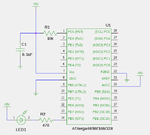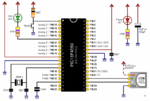rezaeee
Junior Member level 1

Hello!
I am newbie in electronics and my university study field is computer! But I'm very interested to build robots and make electronic boards and controllers for them.
My exact question is that: How can I learn to build a board for my microcontroller, sensors,motors,etc!
I mean, I choose a micro-controller for my robot, and some sensors, some motots, some modules(rf, ect), and then, I want to build a board with this particles. How can I do that? I want to learn building the board with a micro-controller! or better say, I want to learn interfacing micro-controllers with other electronic equipment(sensor,motor,etc) and building my board!
How can I reach to that point? which things there I should learn? Can you give me a Road-map to achieve my goal?
Thanks in advanced , and sorry for bad English!
I am newbie in electronics and my university study field is computer! But I'm very interested to build robots and make electronic boards and controllers for them.
My exact question is that: How can I learn to build a board for my microcontroller, sensors,motors,etc!
I mean, I choose a micro-controller for my robot, and some sensors, some motots, some modules(rf, ect), and then, I want to build a board with this particles. How can I do that? I want to learn building the board with a micro-controller! or better say, I want to learn interfacing micro-controllers with other electronic equipment(sensor,motor,etc) and building my board!
How can I reach to that point? which things there I should learn? Can you give me a Road-map to achieve my goal?
Thanks in advanced , and sorry for bad English!



